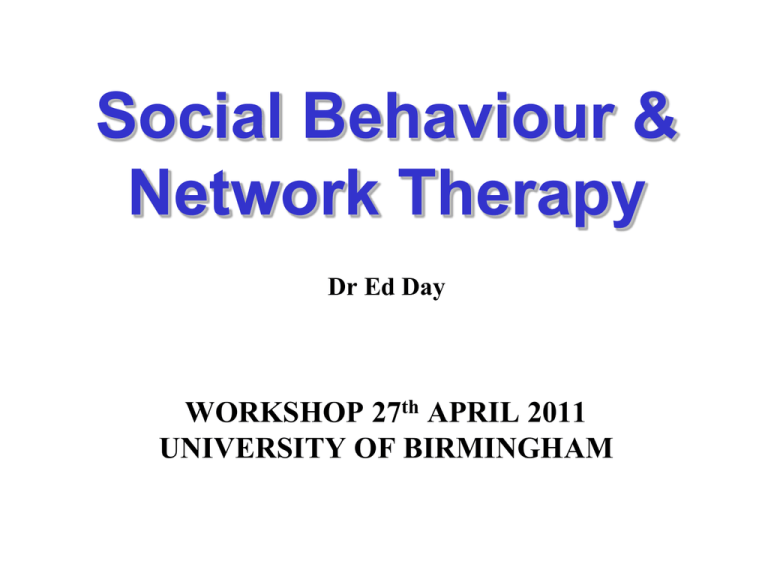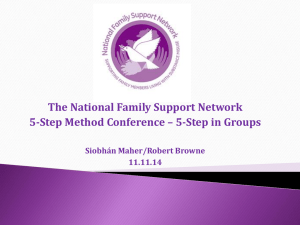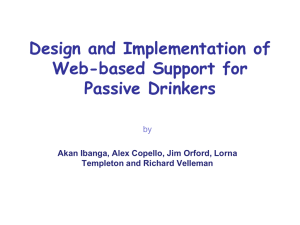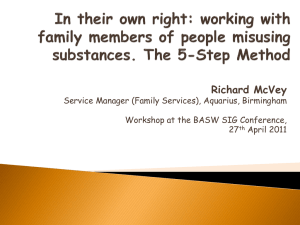Social Behaviour and Network Therapy
advertisement

Social Behaviour & Network Therapy Dr Ed Day WORKSHOP 27th APRIL 2011 UNIVERSITY OF BIRMINGHAM Overview • • • • • • Background Theoretical basis Principles and skills Structure and content Case examples Practical skills Social Behaviour and Network Therapy • A Manualised time limited intervention consisting of 8 sessions • Based on the principle that social behaviour, social interaction and network support for change play a central part in the resolution of addiction problems Family Interventions: Three Broad Categories • interventions that work with family members to promote the entry and engagement of drug and/or alcohol users into treatment • the joint involvement of family members and the relatives using drugs and/or alcohol in the treatment of the user • interventions aimed to respond to the needs of family members affected by drug and alcohol problems in their own right Table 1 : Working with family members to promote the engagement of substance users into treatment or influence the user’s substance related behaviour (Based on Orford et al, 2005) Approaches Description Unilateral Family Therapy (UFT) Thomas et al, 1987; Thomas and Ager, 1993. Partners of relatives with alcohol problems are trained to act as a ‘rehabilitative influence’. Three stages: preparation, intervention to reduce drinking or help the drinker enter treatment, and maintenance of gains. Pressures to Change (PCT) (Australia) Barber and Crisp, 1995; Barber and Gilbertson, 1996. Community Reinforcement and Family Training (CRAFT) Miller et al, 1999; Sisson and Azrin, 1986; Meyers et al, 1999. Designed for spouses of relatives with alcohol problems. Aims to create change in the behaviour of those concerned in order to achieve treatment entry for the relative. By focusing on: education; discussion of family member’s response to drinking situations; setting up activities incompatible to drinking; and preparing the family member to confront the relative and request him/her to seek help. Uses the principles of the Community Reinforcement Approach (Hunt and Azrin, 1973) that focus on the influence of the family, social and vocational aspects in reinforcing abstinence and assisting substance related behaviour change. Cooperative counselling. Yates, 1988 (UK). Aims to develop a co-ordinated strategy for change working with anyone concerned enough to take positive action in response to another’s alcohol problem. ‘Intervention’ (or ‘benevolent confrontation’) Johnson, 1986; Leipman, 1993. Social networks of concerned family members and friends are trained to stage a confrontation, during which attempts are made to reduce ‘denial’ about ‘alcoholism’ and engage the relative in treatment. A Relational Intervention Sequence for Engagement (ARISE) Garrett et al, 1998, 1999. A development of ‘Intervention’ that places less emphasis on confrontation and more on support for family member and relative prior to, during and after treatment entry. A series of strategies are used to respond to calls from concerned others aiming to mobilise family members and social networks to assist the problem substance user’s treatment engagement. Table 2: Joint involvement of family members and substance misusing relatives in treatment (Based on Orford et al, 2005) Approaches Description Family therapy for drug abuse Stanton, Todd et al, 1982; Szapocznik et al, 1988; McLellan et al, 1993; Bernal et al, 1997. Family therapy: structural-strategic, Bowen type or contextual. Behavioral couples therapy O’Farrell et al, 1995, 1992, 1993, 1998; O’Farrell and Murphy, 1995. Combinations of couples treatment in individual couple and group formats. Has been applied to both alcohol and other substance problems. Network therapy Galanter, 1993, 1999. Used alongside individual therapy for the problem substance user, NT uses an active approach to engage members of the substance user’s social network in the treatment process. Social Behaviour and Network Therapy (SBNT) (UK) Copello et al, 2002; UKATT Research Team, 2005. Aims to help a substance user identify potentially supportive family members or friends and to enlist them in providing support for change, where possible engaging them in sessions. Areas covered include: communication, coping, social support, relapse prevention and joint activities. Table 3: Interventions aimed to respond to the needs of family members affected by drug and alcohol problems in their own right (Based on Orford et al, 2005) Approaches Description A psycho-educational approach Dittrich and Trapold, 1984; Dittrich, 1993. Based on understanding of ‘alcoholism’ as a ‘family disease’, attempts to: increase understanding of alcoholism and family interaction; identify and decrease ‘enabling’ behaviours; increase self-esteem; decrease depression and anxiety. Organised in three phases: educational, experiential (in which assertive responses are practised), and goal setting and planning. Al-Anon Family Groups/Families Anonymous Gorman and Rooney, 1979; Miller et al, 1999; Humphreys, 2004. Mutual-help groups for family members, meeting separately from, but affiliated to mutual-help organisations for problem drinking or drug taking relatives. Supported counselling versus stress management versus alcohol focused couples therapy Halford et al, 2001. Three forms of help for women partners of men with alcohol problems Each 15 sessions of one hour aiming to: reduce risk of violence; assist the family member to choose whether to remain in the relationship; and to help her enact a decision to leave or alternatively to improve coping and empower her to influence the partner’s drinking. Based, respectively, on education and non-directive counselling (Rogers, 1991); reducing the stressful impact of the problem for the family member and help to influence the partner’s drinking (Sisson and Azrin, 1986). Parent coping skills training McGillicuddy et al, 2001. Behavioural Exchange Systems Training (BEST) (Australia) Toumbourou et al, 1997, 2001. Counselling for partners in their own right (UK) Howells, 1996; Howells and Orford, 2004. Copello et al, 2000 a,b; Copello et al, 2005. Primary Care Family Intervention Based on a behavioural-analytic model of skill training (Goldfried and D’Zurilla, 1969). Eight weekly two-hour sessions to teach ‘more effective’ coping skills in responding to their adolescents’ substance use. Uses group discussion and role play around a standard set of frequently encountered situations. An 8-week group programme for parents of drug using adolescents: first four weeks focusing on improving parents’ well-being; later weeks aiming to increase assertive parenting responses. Counselling, mostly delivered by trained volunteers, for partners (mostly wives) of relatives with drinking problems, as part of specialised, secondary care services. Emphasized stress experienced by partners and discussion of ways of coping. Based on the Stress-Coping-Support Strain model. Includes 5 steps: (i) giving the family member the opportunity to talk about the problem; (ii) providing relevant information; (iii) exploring how the family member responds to their relative’s substance misuse; (iv) exploring and enhancing social support; and (v) discussing the possibilities for onward referral for further specialist help. The developing evidence of SBNT • UKATT • Implementation with drug users • Including Family Members project Social Behaviour and Network Therapy • Developing clients natural environment • Creating conditions to support change beyond contact with service • Has the potential to help other people affected and concerned by the addiction problem • Manual based but flexible Origins • Need to develop an intervention focused on the social environment • Ellis (1998) Network Support Therapy with alcohol users • Copello et al. (2002) Social Behaviour and Network Therapy in UKATT Copello, A., Orford, J., Hodgson, R. Tober, G and Barrett, C. on behalf of the UKATT Research Team (2002) Social Behaviour and Network Therapy: Key Principles and Early Experiences Addictive Behaviors, Vol. 27, 345-366 Percent Days abstinent Ukatt – United Kingdom Alcohol Treatment Trial: BMJ, 2005, 331, 541-544 & 544-548 Drinks per drinking day Ukatt – United Kingdom Alcohol Treatment Trial: BMJ, 2005, 331, 541-544 & 544-548 Interventions ‘Mesa Grande’ Miller and Wilbourne (2002) Top 8 out of 46 treatments with 3 or more studies included: Social Skills Training CommunityReinforcement Approach Behavioural Marital Therapy ‘Attention to the person’s social context and support system is prominent among several of the most supported approaches’. (p. 276) Theoretical and research basis • Project MATCH evidence • Evidence from Social treatments for Substance-use problems • Research on the experiences of family members e.g. the stress–coping model (Orford et al, 1998) Theoretical and research basis • SBNT = elements of: – Relapse Prevention (Marlatt and Gordon, 1985 ) – Community reinforcement approach (e.g. Meyers et al, 1996) – Network Therapy (Galanter, 1999) – Family Member Intervention (Copello et al, 2000) SBNT: OVERALL AIM • To mobilise and/or develop positive social support for a change in drinking or drug use HOW? • Through a series of sessions focused on a range of relevant topics, the therapist aims to develop a supportive team of concerned others that will not only offer support during therapy but beyond the treatment period • Homework tasks and role play are key components of the therapy Philosophy of Treatment • Social context crucial in substance-using behaviour • Development and consolidation of “social network for change” • Maximise support for positive change, minimise support for continuing substance use • Every person in the room is receiving a service • “Focal person” and “Network members” • Thinking network • The therapist as an active agent of change • The therapist as a task-orientated team leader (cf. family therapist orientated towards insight) User of alcohol/Focal Client Worker/Therapist Families and other important people/Network Members Social Behaviour and Network Therapy – Therapist tasks POSITIVE SUPPORT LEADER ACTIVE AGENT NETWORK FOCUS Social Behaviour and Network Therapy – Therapist tasks …and be able to manage and work with conflict NETWORK MEMBERS • Need to be readily available • Offer positive support but be firm if required • Not have an alcohol or drug problem • Agree with the drinkng goal • Agree to continue to meet • Be prepared to continue to work beyond the therapy period The Treatment Structure • Phase I : Session 1 Identifying the social network • Phase II : Sessions 2 - 7 Combination of core topics and elective topics - building positive support for change • Phase III : Final session Termination and planning for the future Social Behaviour and Network Therapy – Key Components 3 Cs Communication Coping Creating a social environment that supports change SBNT can be applied • with people with readily available networks • with people with networks where there has been conflict and relationships are strained • with those who are isolated • with those concerned even in the absence of the person with the drinking problem Other important issues • Confidentiality • Where treatment takes place • Dealing with the risk of violence Id e n t if y s o c ia l n et w o rk Ph a se I NM p resen t , s u p p o r t iv e NM p resen t , c o n f lic t P r o b le m s e n g a g in g NM ’s FP is o la t e d D e a l w it h c o n f lic t focus on p o s it iv e P h a s e II C o n s o lid a t e n et w o rk su p p o rt f o r c h a n g in g W o r k w it h FP t o en g ag e NM ’s W o r k w it h FP t o b u ild s o c ia l n et w o rk P h a s e III Pre p a ra t io n for the f u t u re The first meeting • • • • • • • • • Welcome those attending Communicate the philosophy of the treatment Communicate the format of future sessions Discuss, if necessary, the treatment goal Discuss the treatment goal with network members and attempt to reach an agreement Conduct a review of the focal person’s current social network Make a decision about who to invite and how to approach them Communicate that anyone from the network can continue to attend all treatment sessions, even if others decide to drop out End session by giving positive feedback Client’s Name: Name: Date: My Social Network 2 2 3 2 3 4 4 5 5 6 9 7 8 4 5 6 9 3 8 6 9 7 8 7 Client’s Name: Name: SHEET 1 Date: 2 2 3 2 3 4 7 5 5 6 8 4 4 5 9 3 6 6 9 8 7 9 8 7 My Social Network 2. Relationship 1=partner 2=immediate family (parent, sibling) 3=extended family 4=friend 5=from work 6=self-help/treatment 7=other 6. In past 6 months, how would you describe this person’s drug use? 5=uses a lot 4=uses a moderate amount 3=uses a little 2=non-user 1=did use, now drugfree 3. In past 6 months, how often have you been in contact? 4. In past 6 months, how important has this person been to you? 5. In past 6months, hoe supportive of you has this person been? 7=daily 6=3-6 times/week 5=once or twice/week 4=every other week 3=about once/month 2=less than monthly 1=once in past 6 months 6=extremely important 5=very important 4=important 3=somewhat important 2=not very important 1=not at all important 6=extremely supportive 5=very supportive 4=supportive 3=somewhat supportive 2=not very supportive 1=not at all supportive 7. In past 6 months, how often has this person used drugs? 7=daily 6=3-6 times/week 5=once or twice/week 4=every other week 3=about once/month 2=less than monthly 1=once 0=not at all 8. How has this person reacted to your drug use? 5=encouraged it 4=accepted it 3=neutral 2=did not accept it 1=left, or made you leave, when you were using 9. How has this person felt about you coming to treatment? 6=strongly supportive 5=supports it 4=neutral 3=mixed 2=opposes it 1=strongly opposes it The IPDA/Social Network Diagram • The Important People Drug & Alcohol (IPDA) Inventory is a research instrument that measures – – – • • • • size of a person’s social network (i.e. number of people they have contact with) the substance use patterns of their social network the level of general and substance-specific support (or discouragement) they get from their network members It normally takes the form of a grid, but here we have combined it with the ‘Network Diagram’ used by SBNT therapists in the first session to draw out a picture of the client’s social contacts The aim is to ‘kill 2 birds with 1 stone’ by completing the research assessment as you draw out the network diagram The network member’s name is written in one of the 12 ovals (2 x 6 per sheet), and each of the 8 questions is answered The answers to the 8 questions are printed out on a separate sheet, and could be given to the client to help them answer the questions Conducting a Review of the Client’s Social Network • Who – Family • Immediate • Extended – – – – – Friends Friends of friends Acquaintances Work Colleagues Professionals • Techniques to broaden the network – Who have you seen/spoken to in the last week? (day-byday) – People you knew ‘before drugs’ – Who is in your phone? – If I asked your mum/partner/brother, who would they add to the diagram? Inviting Potential Network Members • Agree on the most appropriate person to invite with client • Rehearse the invitation process with the client – – – – when and how will they contact them? what will they say? how will they ‘sell’ the treatment? be clear when the next session is • Offer active support to invite the network member – phoning them in the session – helping to write a letter – text reminders Core topics • Communication • Coping • Enhancing social support networks • Developing a network-based relapse management plan Elective Topics • Basic education on drugs/alcohol • Increasing pleasant activities • Employment • Minimising support for drug/alcohol use Meeting Format • Part 1: review of progress [10-15 mins] • Part 2: new material [30 mins] • Part 3: tasks for the next week [10 mins] Communication • • • • Welcome new network members and explain their role Review inter-session change Explain the importance of effective communication Explore the communication skills necessary to invite potential network members to a meeting – – – – – re-establish contact by telephone composing a letter to a potential network member starting conversations receiving criticism feeling talk and listening skills • Explore ways in which the network members can communicate effectively to support the focal person’s substance use goals • End session by giving positive feedback Clearly express what you want Tell the other person why you want it Use “I” statements when expressing your needs Avoid using “you” statements when expressing your needs Make good eye contact Keep your facial expression & gestures consistent with your message Speak loudly and firmly, but without hostility Reply promptly, letting the person know you are sure of yourself Balance the negative with the positive “I know you have tried really hard to be supportive of my problems in the past, but I feel like you have been on my case all the time recently” Acknowledge the other person’s feelings “I know you don’t like going out on your own, but it would be better for me not to drink at the moment” Try to be as specific as possible How useful was this map and discussion? Not useful…1-2-3-4-5-6-7-8-9-10…Very useful Comments: Client Name: Keyworker: Date: / / Coping • Welcome new network members and explain their role • Review inter-session change • Discuss the concept of coping and the ways different people cope • Discuss the advantages and disadvantages of current and past ways of coping with the focal person’s substance use • Agree a strategy or policy for helping the focal person’s efforts to change • End session by giving positive feedback ENGAGED TOLERANT WITHDRAWN Active interaction with the substance user, trying to deal with the problem Removes negative consequences for the user Increasing distance from drug user Example Watching his/her every move, checking up on him/her Give him/her money even if you knew it would be spent on drugs Avoid him/her as much as possible because of drug use Advantage Makes me feel I am doing something positive Avoids arguments Stops me getting too involved – better for my health Disadvantage Very stressful and user he/she doesn’t like it Feel I am being taken advantage of I feel I am rejecting him/her Types of Coping There is no ‘right’ way to cope How useful was this map and discussion? Not Useful 1–2–3–4–5–6–7–8–9–10 Very Useful Comments: Strategy 2 Strategy 3 Disadvantage Advantage Strategy 1 How useful was this map and discussion? Not Useful 1–2–3–4–5–6–7–8–9–10 Very Useful Comments: How Do I Cope? Enhancing social support • Welcome new network members and explain their role • Review inter-session change • Talk about and identify who is and who is not supportive, and match them to different categories • Discuss different types of support • Discuss the factors to be considered when developing a social network • End session by giving positive feedback Think Network Planning Sessions in Advance Therapist as Task Oriented Team Leader SBNT KEY SKILLS Focus on Positive Support Therapist as Active Agent of Change








